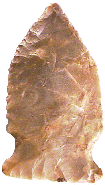
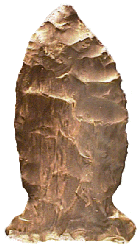
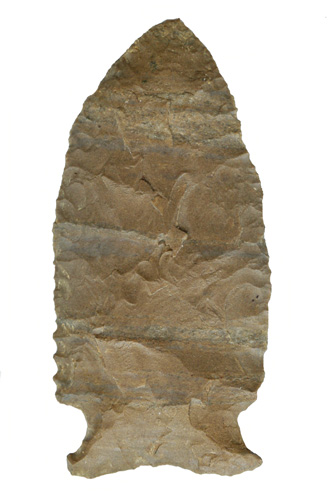
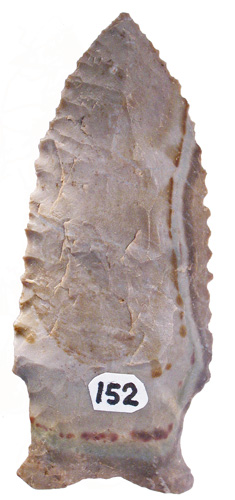




- More Points Shown Below
-
Point Type: GREENBRIER
Also See:
Brunswick, Dalton-Greenbrier, Hardaway, Osceola-Greenbrier, Pine Tree
Location: Southeastern United States
Associated Dates:
9500 - 6000 B.P.- Transitional Paleo -
Early Archaic
Morphology: Side
Notched
General Description: The Greenbrier is a
medium to large, side notched, auriculate point with broad weak side notches.
The prime identification aspects of the blade are heavy grinding in the shoulders and
hafting area and fine secondary edge flaking. The blade shape is basically triangular and varies
from recurvate to
straight due to resharpening of the blade edges. Resharpening was
typically accomplished at a steep angle which resulted in bifacially
beveled blade edges. The
blade edges usually include fine serrations.
The Greenbrier, due to the following
variants is a difficult point to type and identify. The ground
base of the Greenbrier can take on a variety of outlines; it can
be concave, lobbed, eared, straight or bifurcated. To further
complicate identification matters, very early examples can be
fluted. The hafting area displays broad side
notches which are created
as the shoulder
tapers into the expanded stem.
It is believed that this type developed from the Dalton type as well as from the Clovis type and then later evolved into the Pine Tree type.
At the Hester site in Mississippi
(Brookes 1975) a large number of Greenbrier points were recovered
which revealed a wide range of manufacture and resharpening
stages. Edge wear on these specimens indicated use as both knives
and spear points.
The Greenbrier was named by T. M. N. Lewis in 1958 for examples which recovered from the Nuckolls' site in the Greenbrier area of Kentucky Lake, Tennessee. The size of the Greenbrier can range from 40 mm to 80 mm in length based upon a small sample size (6).
About The Point Above (Left): The point pictured above on the left side of the page, is a very small Greenbrier point made from a glossy brownish, greenish flint material with a few tan colored inclusions. The point measures 48 mm in length, 26 mm across the auricles, and is 9 mm thick. The stem is 20 mm wide at the notches and is 13 mm long. The blade is 25 mm wide. The base has been thinned and ground as have the notches. The edges have slight serrations and are quite sharp. This point was found in Jackson County, Alabama. Catalog Number 64-28-D
About The Point Above (Left
Center): The
point pictured above on the left center of the page, is a
Greenbrier point made from a glossy dark brown or bark colored
flint material with a few tan and cream colored inclusions. The
point measures 64 mm in length, 38 mm across the auricles, and is
a very thin 6 mm thick. The stem is 21 mm wide at the notches and
is 14 mm long. The blade is 29 mm wide. The base is slightly
concave and has been thinned and ground as have the notches. The
basal ear on the left is more pointed than the rounded basal ear
on the right. This point was found outside of the town of
Childress Hill, Hardin County, Tennessee. Catalog Number 133-88-D
About
The Point Above (Center): The point pictured above on the
center of the page, is a Greenbrier point made from
a dull, dark brown Dover Chert material. The point
measures 65 mm in length, 31 mm wide at the shoulders, 29 mm across
the auricles, and is 7.5 mm thick. The stem is 22 mm wide at the notches
and is 12 mm long. The blade is bifacially beveled. The blade edges are
slightly serrated on the left hand side of the blade near the base. The
base is slightly concave and has been thinned and ground as have the
notches. This point was found in Tennessee. Catalog Number 157-45-V
About The Point
Above (Right Center): The point
pictured above on the right center hand side of the page, is a Greenbrier point made from
a semi glossy three toned gray-tan, dark brown and cream colored banded
flint material with a few tan and cream colored inclusions. The flint
is banded with dark and light colors. The point
measures 61 mm in length, 27 mm wide at the shoulders, 24 mm across
the auricles, and is 7.9 mm thick. The stem is 21 mm wide at the notches
and is 15 mm long. The blade flat on one side and unifacially
beveled resulting in a boat shaped profile. The blade edges are
serrated. The base is concave and has been thinned and ground as have
the notches. This point was found by Tony Clinton in Livingston, KY.
Catalog Number
152-119-D
About The Point Above
(Right):
The point pictured above on the far right hand side of the page,
is a Greenbrier point made from a dull dark brown and green or bark
colored flint material with a few
tan and cream colored inclusions. The flint appears banded with dark and
light colors. When the flint is wet the colors really show
well. The point measures 56 mm in length, 29 mm across the auricles, and is 8.4
mm thick. The stem is 25 mm wide at the notches and is 13 mm long.
The blade is 29 mm wide. The base is concave and has been thinned
and ground as have the notches. The upper basal ear on the
(left) is more pointed than the rounded basal ear on the right. This
point was found outside of the town of Childress Hill in a creek
bank wash, Hardin County, Tennessee. Catalog Number
188-40-C
About The
Point Below: The point pictured below (twice
size) in the center of the page, is a Greenbrier point made from a dull
chalky, white or tan Jeffersonville chert material with a
few specks of tan and cream colored inclusions. The
point measures 46 mm in length, 26 mm across
the auricles, and is 7 mm thick. The stem is 21 mm wide at
the notches and is 10.8 mm long. The blade is 24 mm wide at the barbs. The base
is concave and has been thinned and ground as have the notches. The point
has very steep unifacial bevels which are on the left side of each
face. This point was found in Carroll County, Indiana.
Catalog Number
424-7-AC
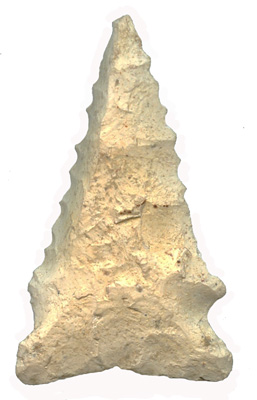
References: Baker, Bell (2), Cambron & Hulse, Justice (1), Overstreet, Perino (1)
© Copyright 1997 - 2009 LITHICS-Net WWW.LITHICSNET.COM
Use your Browser's BACK Button to return to the LITHICS-Net Index.